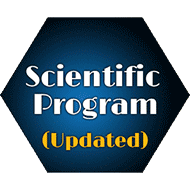
Biography
Biography: Wael M Abdelaal
Abstract
Adverse reaction to cows' milk resulting from an immunologic hypersensitivity to one or more milk protein. the most common food allergy in infants and can affect the quality of life of the whole family
It affects 1.9% - 4.9% of infants. According to the guidelines from the national institute of allergy and infectious disease it classified into.
IgE- mediated CMPA, Symptoms can occur immediately and up to 2 hours after ingestion of cow’s milk., Can affect skin, respiratory system, GIT or severe systemic reactions---- anaphylaxis
Non IgE-mediated CMPA. Manifestations can be delayed up to 72 H after exposure to cow’s milk. Main effects to GIT. Symptoms are non-specific including colic, reflux, diarrhea or constipation, blood in stool and exacerbation of eczema
Cow’s Milk Antigens. More than 25 proteins in cow’s milk can induce antibody production in humans. β-lactoglobulin (in whey), casein, and bovine serum albumin are the most important antigens. Clinical reactions have occurred to all the major cow’s milk antigens
Human Milk Antigens. Human milk is predominantly whey (80% whey and 20% casein) – total casein content varies during lactation (20% in early lactation, 45% in late lactation) . Human milk lacks αs1 and αs2 caseins and β - lactoglobulin
Predisposing Factors to CMPA in Breast-fed Infants. Genetic predisposition – family history of CMA, Early exposure to cow’s milk – in utero – in newborn nursery, Exposure to cow’s milk allergens – in mother’s milk, Feeding of cow’s milk by relatives and caregivers
Clinical presentation of CMPA. CMPA manifestations involves many organs, mostly skin, GIT and respiratory tracts. The involvement of 2 or more systems increases the probability of CMPA
Studies on infants with CMPA showed that half of them have atopic eczema, and 25-50% are affected by GIT manifestations whereas other clinical manifestations are less common
How to diagnose CMPA?
1-Allergy-focused history ( symptoms, underlying immunological mechanisms and linking this to suspected food, family history of atopy).
2- For IgE mediated---- skin prick tests or specific IgE blood tests.
3-For non IgE mediated---- allergy tests have limited value
4- The oral food challenge test remains the gold standard for both types.
Treatment. Strict avoidance of CMP is the safest strategy. Choosing the substitute formula., hydrolyzed formula AAP defines eHF that it is a formula containing only peptides that have a molecular wt <3000Da.Majority of children are tolerating it. Formula containing free amino acids as the only nitrogen source are the best option in infants reacting to eHF
Prognosis. 50% of children develop tolerance by age 1 yr.75% by age 3 yrs.90% by age 6 yrs. Most infants will outgrow milk allergy by 3 years of age, but may become intolerant to other foods.

